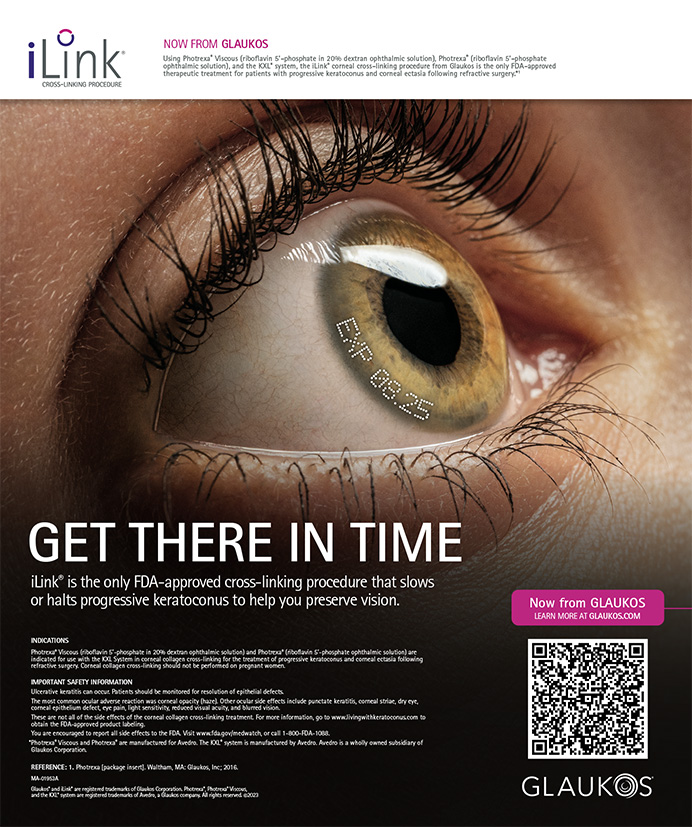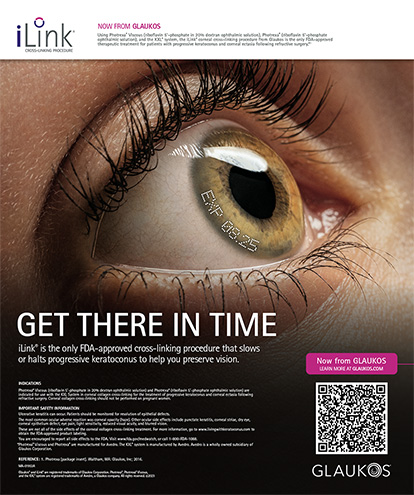I believe that the category of microinvasive glaucoma surgery (MIGS) will transform the management of glaucoma. Although some surgeons remain skeptical of the procedure and the efficacy of the iStent Trabecular Micro-Bypass (Glaukos Corporation), I expect this category to fill a void that has long existed in surgical glaucoma—an outflow procedure that is safe, minimally invasive, efficient, and widely adoptable.
TRADITIONAL GLAUCOMA SURGERY
Surgically active glaucoma specialists have a lovehate relationship with traditional glaucoma surgery. We have learned to make trabeculectomy a reasonably good operation, and we have determined how to reduce or eliminate most perioperative complications. When I encounter a patient with a severe intra- or perioperative complication, I find solace in the fact that, during my very next clinic, I will encounter numerous patients who have done beautifully with a tube or a trabeculectomy.
The intraoperative and perioperative experience is not the primary reason that many of us have longed for a less invasive and safer glaucoma procedure. The main factor is that many elements of trabeculectomy are beyond our control as surgeons, especially with regard to the healing whims and biological variability of the conjunctival-Tenon complex. Trabeculectomy and tube shunts are suboptimal procedures for early to moderate glaucoma, because there is no end to the period during which the patient is at risk. Late infections and bleb leaks can turn a seemingly successful case into a disaster days, months, years, or even decades later. Further, the most serious complication, bleb-related endophthalmitis, is iatrogenic, completely unrelated to the primary disease process. Thus, although trabeculectomy remains the best operation for patients at high risk of developing a functional impairment from glaucoma, it is hardly an ideal procedure for those with earlier stages of the disease.
NEW DEVELOPMENTS
I believe Glaukos Corporation should be congratulated on successfully completing the most rigorous clinical trial ever conducted for a glaucoma device. It was the first prospective, randomized, premarket approval/investigational device exemption clinical trial for a glaucoma device involving physiological outflow. The efficacy of a single iStent was modest in the premarket approval trial (discussed later), but the safety of the device was impeccable. Further, as with many new surgical devices, surgeons will find ways to make improvements once they begin working with the iStent. Surgeons in Canada and elsewhere have reported improved efficacy with multiple stents. New designs by Glaukos Corporation and devices by other innovative startup corporations in the glaucoma space are under investigation, and the FDA's recent approval of the iStent has sparked important momentum in this area.
SPECIFICS
Optimal Incision and Visualization
The iStent is truly minimally invasive and microincisional: the optimal incision size is 1.5 to 2 mm through clear cornea. The corneal incision should be made as peripheral in the cornea as possible without violating the conjunctival insertion. If the corneal incision is too anterior (ie, too corneal), the gonioscopic lens may interfere with the iStent's inserter. After the incision is made, the anterior chamber is filled with viscoelastic material. The patient's head is turned away from the surgeon, and the microscope is tilted toward the surgeon to optimize visualization of the angle. It is imperative to maintain a clear view of the angle's structures through the gonioscopic lens. The view must be maintained throughout deployment of the stent. As such, movement of the patient and undue pressure on the wound should be eliminated.
Placing the Stent
If the anterior chamber shallows during the procedure, the view is lost, and accurate placement of the stent is unlikely. The tip of the device should approach the trabecular meshwork (TM) at a slight angle, perhaps 10º to 15º. Once the tip pierces the TM, the approach should be more flat to facilitate passage of the implant into the canal. If too much angulation is maintained, the tip of the device will engage the posterior wall and preclude complete intubation of the canal. The stent is then gently advanced into the canal. The translucent TM typically allows visualization of the device within the canal. The stent should be parallel to the scleral spur, which is typically the best landmark within the angle.
Insertion
Once the surgeon is confident of the device's accurate placement, he or she depresses the inserter button, thereby disengaging the stent. The tip of the inserting cannula is used to gently tap or nudge the iStent forward, allowing the heel of the stent to drop securely within the canal. The snorkel should be surrounded by TM, which forms a supportive collar. When properly placed, the device should be stable and secure. If the stent appears to be malpositioned or unstable, it can be regrasped with the inserting device and placed a few clock hours away in a fresh location. Once proper placement has been achieved, the residual viscoelastic material is evacuated from the anterior chamber. The incision should be checked to make sure that it is self-sealing and not leaking. Typically, no suture is necessary.
Filling a void
MIGS procedures will help to fill a void in glaucoma management. Glaucoma surgeons have recognized that cataract surgery presents an opportunity to completely reassess whether glaucoma management should be medical or surgical. For example, from 1995 to 1999, nearly two-thirds of trabeculectomies were performed at the time of cataract surgery.1 Increased awareness that cataract surgery itself lowers IOP,2-4 that trabeculectomy poses a significant and sustained risk, and that modern clear corneal cataract surgery spares the conjunctiva has led to a dramatic reduction of combined cataract and glaucoma surgery. I believe that the MIGS category will reinvigorate combined surgery.5 Cataract surgery will once again be viewed as an opportunity to surgically manage glaucoma in attempt to lower IOP, decrease patients' dependence on topical medication, and reduce the morbidity of poor medical compliance, all without significantly increasing the risk of cataract surgery alone. Bravo! Perhaps most exciting of all, considerable research is underway investigating updated versions of the iStent and several other devices. The best is yet to come.
Thomas W. Samuelson, MD, is an attending surgeon at Minnesota Eye Consultants and a clinical associate professor at the University of Minnesota in Minneapolis. He is a consultant to Alcon Laboratories, Inc.; AcuMems; Allergan, Inc.; Abbott Medical Optics Inc.; AqueSys Inc.; Endo Optiks; Glaukos Corporation; Ivantis Inc.; Merck & Co.; and QLT Inc. Dr. Samuelson may be reached at (612) 813-3628; twsamuelson@mneye.com.
- Coleman AL, Yu F, Rowe S. Visual field testing in glaucoma Medicare beneficiaries before surgery. Ophthalmology. 2005;112(3):401-406.
- Mansberger SL, Gordon MO, Jampel H, et al. Reduction in intraocular pressure after cataract extraction: the Ocular Hypertension Treatment Study. Ophthalmology. In press.
- Samuelson TW, Katz LJ, Wells JM, et al. Randomized evaluation of the trabecular micro-bypass stent with phacoemulsification in patients with glaucoma and cataract. Ophthalmology. 2011;118(3):459-467.
- Poley BJ, Lindstrom RL, Samuelson TW, Schulze R Jr. Intraocular pressure reduction after phacoemulsification with intraocular lens implantation in glaucomatous and nonglaucomatous eyes: evaluation of a causal relationship between the natural lens and open-angle glaucoma. J Cataract Refract Surg. 2009;35:1946-1955.
- Samuelson TW. The fall and rise of combined surgery? EyeWorld. March 2011. http://www.eyeworld.org/ printarticle.php?id=5756. Accessed August 7, 2012.


